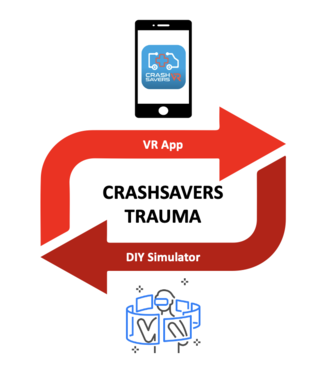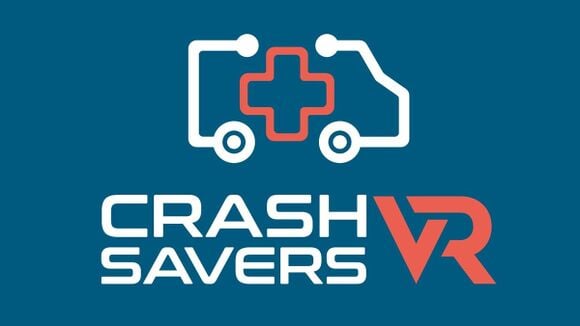In this page you will get an overview on our Mission, purpose and introduction to our simulators
Our Mission[edit | edit source]
Our training course will empower paramedics in Guatemala with the skills, competence, and confidence to perform different hemorrhage control techniques as part of the initial trauma triage in the pre-hospital environment.
Why CrashSavers Trauma?[edit | edit source]
Hemorrhage is the leading cause of preventable death after trauma with up to 40% of deaths in traumatically injured patients.[1][2] It only takes minutes for an individual to bleed to death, so decisions surrounding hemorrhage control must be made within seconds.
In high-income countries, first-responders (ie. paramedics, police officers, firefighters) are trained and skilled in hemorrhage control techniques[3][4], though this is not the case for low- and middle-income countries such as Guatemala, which lacks a formalized EMS system. Emergency prehospital care for the entire country of Guatemala is only provided by 3 firefighting organizations with a total of 8,500 firefighters, of which half are volunteers. Firefighters of Guatemala, or bomberos, are involved with all types of emergencies, from childbirth to shootings to natural disasters. However, the medical training they receive is basic, and only 1 of the 3 organizations provides the option for a non-mandatory formal EMT course. Furthermore, many traumas occur in rural areas with minimal to no trauma centers, scarce blood bank capabilities, and dramatically variable–and often excessive–-hospital transport times.
Inadequate or incomplete training leads to poor hemorrhage control techniques, which ultimately can lead to ongoing bleeding and death that are most likely preventable. Studies have shown that practice in hemorrhage control, particularly advanced maneuvers such as tourniquet application, is shown to be effective.[5] Untrained personnel were found to have unacceptably high rates of tourniquet failure when given tourniquets to utilize without any additional training aside from package instructions. Thus, formalized training and hands-on practice are essential.[6]
Our design of a low-cost, portable simulator and assessment tool for hemorrhage control techniques has the potential to markedly advance the efficacy of care through one of the most effective and practical interventions in trauma management. There is currently no training focused on hemorrhage control techniques in Guatemala, as well as in many other low- and middle-income countries in Latin America, for prehospital employees and volunteers. We have created a novel, hands-on training model to teach hemorrhage control techniques that has broad implications in considerably reducing prehospital morbidity and mortality from traumatic hemorrhage.
In the CrashSavers Trauma course, prehospital providers will learn 4 techniques for hemorrhage control:
- Application of external pressure to a bleeding superficial wound
- Application of packing into a bleeding deep wound
- Application of a tourniquet to a bleeding extremity
- Insertion and deployment of a foley catheter in a wound that is profusely bleeding or in an anatomic junction (ie. base of neck, axilla, groin)
Our training model includes: 1) a smartphone application that contains educational material and video instruction to learn techniques, linked to a VR simulator to practice techniques digitally prior to practicing on a physical model, and 2) a physical DIY simulation model of an extremity built with low-cost materials to replicate blood flow.

Our Simulation[edit | edit source]
Effective hemorrhage control requires prompt, decisive action through the forceful application of pressure. Through our course, participants will learn how to externally compress a wound, apply a tourniquet, and deploy foley catheters to slow down and stop bleeding. We chose to present a series of hemorrhage control techniques in our simulation model, as these skills are often taught merely by observation and without substantial feedback on how to appropriately apply pressure to stop bleeding.
For instance, the successful use of tourniquets often requires higher-than-expected amounts of pressure. Baruch et al[7] noted a “confidence-competence mismatch” when observing non-medical users apply tourniquets and investigating reasons for failure. They reported a common reason for tourniquet failure was excessive slack in the straps and too few turns of the windlass, based on an underestimation of the amount of pressure required to successfully deploy the tourniquet. Our model uses dynamic pump-based fluid technology to generate visual and tactile feedback for sufficient compression to stop the bleed. The use of a dynamic model that simulates active bleeding and provides sensorimotor feedback to the learner addresses the shortcomings of a standard, hands-on training model for tourniquet application. This may ultimately result in fewer tourniquet failures from inadequate compression.
Hemorrhage control by foley catheter can be applied in 2 different scenarios. First, in patients with deep, narrow wounds in an extremity, such as from a penetrating injury, foley catheters are a low-cost method to provide direct compression to the wound without provoking additional ischemia of the distal extremity, which can be the case with tourniquet application. This method is particularly useful with prolonged transfer times from rural areas, as well as with long wait times prior to definitive surgical management when the patient arrives at a trauma center. Second, foley catheters can be used for hemorrhage control for wounds at anatomical junctions such as the axilla or groin, where tourniquets cannot be applied.
Our simulation model consists of 2 essential components for learners to practice and apply different hemorrhage control techniques. The first is knowledge acquisition through virtual interactive cases using a mobile gamification app. This virtual platform provides all of the educational and technical information required to learn indications and steps to perform pressure and packing, and place a tourniquet and foley in a clinical scenario. Gamification strategies promote and incentivize mastery learning prior to transitioning to physical model-based training. The second approach is simulation-based training in a physical lower limb module that allows learners to practice different hemorrhage control techniques (i.e., place a tourniquet, foley catheter, or apply pressure).
In our model, the pressure exerted through the effective application of external pressure, packing, tourniquets, or foleys to stop hemorrhage will be measured and can be translated into clinical efficacy to ensure appropriate skill execution. Repetition and continuous practice are the keys to learning, and the powerful combination of the VR app and physical simulator provides a comprehensive module to acquire and master the necessary skills. The firefighters of Guatemala, as well as all other learners in our course, will be able to employ the learned hemorrhage control techniques in their daily practice of rescuing and managing bleeding patients.
¿How to use our Modules?[edit | edit source]
We have integrated our Appropedia modules, mobile application, and physical simulators by synchronizing every platform so the user can understand how to use it. Lets do a general walkthrough of our learning steps on our mobile application. The navigation process is similar on these appropedia pages.
After installing and registering in the CrashSavers mobile app, the software begins a tutorial on the correct order of our modules. The first step the user has to do is to study and rehearse the Learning Material. The second step is to build the simulators; the building manuals are ready to download on the Appropedia site and our Mobile App. The apprentice will find the materials required for building and assembly in this manual. We have included videos on the creation process and how to use our simulators.
Afterward, the user can start challenging himself on our clinical case scenarios. They provide instant feedback on each step of hemorrhage control and will guide the user on the correct indications of each technique.
After practicing with the simulator, the learner needs to complete a self-assessment inside our application or through our Appropedia site, allowing proficiency valorization of the acquired skill.
References[edit | edit source]
- ↑ Curry N, Hopewell S, Dorée C, Hyde C, Brohi K, Stanworth S. The acute management of trauma hemorrhage: a systematic review of randomized controlled trials. Crit Care. 2011;15(2):R92. doi:10.1186/cc10096
- ↑ Rhee P, Joseph B, Pandit V, et al. . Increasing trauma deaths in the United States. Ann Surg. 2014;260(1):13-21.
- ↑ Bulger EM, Snyder D, Schoelles K, Gotschall C, Dawson D, Lang E, Sanddal ND, Butler FK, Fallat M, Taillac P, White L, Salomone JP, Seifarth W, Betzner MJ, Johannigman J, McSwain N Jr. An evidence-based prehospital guideline for external hemorrhage control: American College of Surgeons Committee on Trauma. Prehosp Emerg Care. 2014 Apr-Jun;18(2):163- 73. doi: 10.3109/10903127.2014.896962. PMID: 24641269.
- ↑ American College of Surgeons BleedingControl.org—about us. http://www.bleedingcontrol.org/about-bc.
- ↑ Baruch EN, Benov A, Shina A, Berg AL, Shlaifer A, Glassberg E, Aden JK 3rd, Bader T, Kragh JF Jr, Yitzhak A. Does practice make perfect? Prospectively comparing effects of 2 amounts of practice on tourniquet use performance. Am J Emerg Med. 2016 Dec;34(12):2356-2361. doi: 10.1016/j.ajem.2016.08.048. Epub 2016 Aug 27. PMID: 27614373.
- ↑ Dennis A, Bajani F, Schlanser V, Tatebe LC, Impens A, Ivkovic K, Li A, Pickett T, Butler C, Kaminsky M, Messer T, Starr F, Mis J, Bokhari F. Missing expectations: Windlass tourniquet use without formal training yields poor results. J Trauma Acute Care Surg. 2019 Nov;87(5):1096-1103. doi: 10.1097/TA.0000000000002431. PMID: 31274827.
- ↑ Baruch EN, Kragh JF Jr, Berg AL, Aden JK Rd, Benov A, Shina A, Shlaifer A, Ahimor A, Glassberg E, Yitzhak A. Confidence-Competence Mismatch and Reasons for Failure of Non Medical Tourniquet Users. Prehosp Emerg Care. 2017 Jan-Feb;21(1):39-45. doi: 10.1080/10903127.2016.1209261. Epub 2016 Aug 5. PMID: 27494564.

